Alicia Silverstone's Blog, page 9
August 3, 2023
5 Healthy Foods That Fight Migraines
Migraine headaches affect 25 percent of the female population and about 8 percent of the male population. Most people who suffer from migraines head straight for the medicine cabinet, but there are foods that can help reduce the frequency and severity of migraine headaches. These are the best ones.
I used to get severe migraines as a kid. The pain was so unbearable! I have memories of praying so intensely for it to stop because it would hurt so bad. Thankfully, I have not had one since I changed my diet to a kind one.
Migraines are a type of headache characterized by intense, debilitating pain. They can last for hours or even days, and can significantly interfere with a person’s daily activities. Migraines are often accompanied by other symptoms beyond just headache, which can include:
Aura: These are sensory disturbances that often precede the headache. They can include visual changes such as seeing flashes of light, zigzagging lines, blind spots, or other symptoms like tingling on one side of the face or in an arm or leg.Nausea and vomiting: Many people with migraines experience these symptoms during an attack.Extreme sensitivity to light and sound: During a migraine, people often find that light and noise make their headaches worse.Lightheadedness, sometimes followed by fainting: These are less common symptoms but can occur in some people.Migraines are often divided into two main types: migraine without aura and migraine with aura. Some people will always experience an aura before a migraine headache, while others will never experience an aura.
The exact cause of migraines isn’t completely understood, but they seem to involve changes in the brain and genetic factors. Certain triggers can also increase the risk of having a migraine. These can include stress, certain foods and drinks, lack of sleep, and hormonal changes in women.
Treatment for migraines can include a combination of medications, lifestyle changes (such as identifying and avoiding triggers), and sometimes complementary therapies like acupuncture.
Which foods cause migraines?Since migraines aren’t fully understood, their triggers aren’t either. But there are a handful of foods connected to migraines including caffeine, alcohol, cheeses and processed meats, as well as food additives including aspartame and other artificial sweeteners, and MSG (Monosodium glutamate), a flavor enhancer used in many types of food.
Foods that fight migrainesIf you follow a kind diet but still get migraines, I recommend you see a macrobiotic counselor. For now, here are five foods that have been shown to help fight migraines.
1. Millet [image error]Millet contains migraine-preventing magnesium. Try it for breakfast in my millet and sweet vegetable porridge.
The research is still in its infancy ,but flaxseed is high in omega-3s, and some studies have shown that Omega-3s can reduce the frequency of migraines
At least one study concluded that Olive Oil (also high in omega-3s) reduced the length, intensity, and duration of migraine attacks in adolescents.
Vitamin B2 (riboflavin) is a major weapon in the battle against migraines. Spinach has some of the highest amounts of riboflavin among other vegetables*.
 5. Water
5. WaterDehydration is a common trigger for migraines, so before you reach into the medicine cabinet, or start chowing down, make sure you’ve had your H2O!
Other foods believed to fight migraine headaches are peppermint, cayenne pepper, ginger, wheat germ, soy, and many dark leafy vegetables.
July 29, 2023
Easy Toasted Nori Burritos With Creamy Vegan Tahini Dressing
These nori rolls have evolved over time—most of the time we make them super quick with sauerkraut, avocado, and paprika. Other times it’s like in the video with sweet potato (Cuban-Style Roasted from my book The Kind Diet or just plain baked).
We top them with radicchio, sprouts, tahini, basil, cilantro, and apple. There are other variations in The Kind Diet on p. 219, but really the sky is the limit here.
There are lots of creative tasty ways to make these rolls—that’s why there’s no need to give you super detailed recipe instructions.
Just take a sheet of nori and fold it into fourths, then add all the goodness! Try making them the way I did in this video, it’s freaking delicious!
Tahini is a staple for us. The dressing I make is linked below. Another yummy tahini recipe is in my book The Kind Diet on p. 263.
Cilantro leavesSprouts DirectionsLightly toast the nori sheets. Layer in kraut, greens, avocado, sweet potato and top with tahini. Garnish with paprika. That’s it! Enjoy!
July 28, 2023
How To Make Soil
What if there was an opportunity to be kind to the planet right under our noses? Think for a moment about those bits of the Earth that are left over after they have fed and nourished us? Veggie scraps, coffee grounds, leftover tea bags, and even dirty napkins (which were once trees!). These pieces of Earth gave us life and enjoyment, and in turn, we take them and… throw them in the trash can.
Wait, what?
That’s right — every day, in most places on Earth, people are accustomed to tossing the remnants from food-prep (or foods that have spoiled) into the waste bin, where they are hauled off by big smelly trucks and dumped into a landfill. If you think about it, that’s literally treating the planet like garbage!
When those bits of Earth go off to a garbage dump they rot and produce methane, a potent greenhouse gas that exacerbates climate change. And by being mixed in with all that garbage their valuable nutrients are forever taken out of our food system. It’s a broken loop, not at all in harmony with nature, and it means that our food system is essentially becoming less nutritious by the day. And it’s completely unnecessary. Because instead, all of those beautiful bits of Earth can be turned back into new, living soil — soil that can be used to grow more healthy and delicious food.
This is why we created MakeSoil. MakeSoil makes it easier than ever to begin composting. To get started, just go to MakeSoil.org and search the map to find a soil site near you. Soil sites are hosted by neighbors called Soil Makers, who love these precious bits of Earth, and know how to turn them back into soil. All you need to do is join their soil site and begin taking your scraps to them. Week after week you’ll see your food scraps disappear and new, living soil build up in place.
Not only does making soil feel way better than making garbage, but to witness the Earth regenerating itself in this way is a truly transformative experience, leaving us with an even greater sense of connection with – and empathy – for the Earth.
 MakeSoil is a global movement. Find a soil site near you. Or start one!
MakeSoil is a global movement. Find a soil site near you. Or start one!Now maybe you’ve been reading this and thinking, “Me! Me! I have a compost bin! I know how to make soil.” If so, would you please add your compost bin as a soil site on MakeSoil? It really is one of the simplest and most immediate ways to begin having a positive impact on your neighborhood. If enough people participate, we could even help address climate change.
MakeSoil is also about having a good time. So we let you set privacy levels and participation limits so you end up with just the right number of trusted “soil supporters” making soil with you.
The power to create new living soil is in our hands. So why treat the planet like garbage, when we can make soil instead!
*p.s. — Some cities and towns have curbside compost pickup services. Worldwide, these are still relatively rare and it’s estimated that over 90% of compostable materials are still headed to landfills. Even places that have had such programs in place are finding it challenging to operate them due to financial strain from the Covid pandemic. MakeSoil can help – so please tell your friends! Besides, by participating you’ll build community, stimulate the local food system, and get way better feels than by chucking your compostables into a curbside bin.
 MakeSoil Founder, Josh Whiton teaching new Soil Makers.
MakeSoil Founder, Josh Whiton teaching new Soil Makers.Josh Whiton is the Founder of MakeSoil. MakeSoil is a 501c3 not-for-profit organization that develops and maintains the MakeSoil platform, which is being increasingly used world-wide. Donations are greatly appreciated and are essentially for powering this global movement to take better care of the Earth. Follow MakeSoil on Instagram here.
July 26, 2023
5 Easy Zero-Waste Steps to Live Trash-Free
Going trash-free can seem impossible, but with a few simple zero-waste steps, it can be as easy as making trash. Here’s how to do it.
More than 100 million marine mammals are killed by plastic pollution per year and 50% of all plastic is single-use. There are so many alternatives to combat pollution every day and it’s up to us to do it! What do you waste in one day? Keep a note in your phone, or better yet, I dare you to save all of the things you’d normally throw away in just one day! The wrappers, coffee cups, dirty napkins, chip bags, etc… Not only would you feel messy, but it puts into perspective what you are expelling out into our planet. Trash and plastics stay on earth for up to a thousand years!
In an aim to eliminate waste in my life, I’m outlining 5 simple steps below that have helped me through this journey.
Become aware of what you really need and what you are better without. Make piles. If there is a “maybe” or “what if” pile, get it out of there! Ask yourself first if you can donate or sell it. You won’t miss it, I promise. If you got rid of these “no’ and “maybe” piles then all you have left is the “I love this” pile, and that’s what we want our spaces to be filled with. If you use something often but it consists of trash or plastic (lip balms, shampoo, spices etc…), use it up. It’s better to use what we have first and phase out of it.
2. IdentifyWhile you’re taking inventory of all the items in your home, identify where you generate trash and plastics – the makeup containers, kitchen supplies, your bathroom essentials, etc… Look at your “get rid of” pile and your trash can. Take note of these items and think of the overall sustainability of the item (its source, material, environmental impact, lifespan, and end result). Reflect on how much better you will feel knowing that your entire life will soon be cleansed of things you and the earth are not benefitting from, as well this newfound consciousness in day-to-day life.
3. PrepareYay! It’s time to take action! To prepare, it’s helpful to make a quick list of JUST the things you threw away while you were out of the house, and on a general day. What’s the coolest thing about this list? The realization is that every single item can be easily replaced by reusable and sustainable products and that we have the power to combat plastic pollution, overflowing landfills, and wasting resources.
4. PurchaseHere’s a basic list of items that can start you off. Although buying alternatives is important, there are also some amazing recipes that you can make to replace toothpaste, mouthwash, lotion, and more! The biggest thing to remember is that being prepared is the most successful route to being trash free.
5. AdaptThis step is the most fulfilling! You start to notice how thankful you start to become every single day. You realize all the moments you would normally waste such as throwing your food away or buying a coffee now becomes so sweet. Presence and beauty renewed in what used to be mundane things. It is the best feeling to know the food scraps you take to the farmers market compost drop off have a new life as a tree. It’s amazing to use up that last plastic toothpaste bottle because you made your own with peppermint and lavender. To buy a coffee and realize it tastes so much better in your own reusable cup.
An important everyday reminder: You will mess up! There will be times that you accidentally go to the market and forget your produce bags or your reusable cup for coffee in the morning. Or times that are out of your control when the waitress brings you a straw when you told her twice not to put one in there. In order for this waste-free journey to stick in your life, we have to remember perfection is impossible. As long as you are doing your best with intention, you are on the right track. This is all part of adapting. Your alternative choices will eventually integrate into your life and it will be a normal part of you.
July 18, 2023
Yum Snacks + Lunch Ideas for School!
Packing your little one’s lunch is so sweet and fun. But making food they like can be stressful. You don’t want them coming home with a lunchbox full of uneaten food — that’s bad for the planet and your bank account! Check out my school snacks and lunch ideas below. If you are in college, check out Moriel’s words on college kind style. For more info on healthy snacking, read my guide to kind snacking. Happy eating!
My mantra for putting together Bear’s lunch is grain – protein – vegetable! Here are some more lunch ideas or snack components we use on a regular basis:
grains
vegetables
steamed or sautéed green beans with a little shoyu and lemonsteamed broccoli with Vegenaise or a flax umeboshi plum dressing as a diparugula saladcollard greens with smoked tofu wrapped insidecarrots stickssteamed or blanched cabbage/kale with umeboshi plum flax dressingbaked sweet potatoesproteins
beans! black-eyed peas, black soybeans (he used to love these), lentils, garbanzo beanshummusfried tofuProtein-Packed Waffles from The Kind MamaDave’s Gourmet Korean Food tempeh – we get this at the farmers market, Bear loves this!!Wildwood baked savory tofu – this one has no sugar Rhapsody Tempeh – if you’re vegan, you have to know about Rhapsody! They make the best tempeh. I love the teriyaki kind. They are organic and use soybeans grown less than 100 miles away from their base in Vermont.non-gmo edamame
Rhapsody Tempeh – if you’re vegan, you have to know about Rhapsody! They make the best tempeh. I love the teriyaki kind. They are organic and use soybeans grown less than 100 miles away from their base in Vermont.non-gmo edamameon the sweeter side
apple saucebrown rice crispies from The Kind Dieta handful of blueberries, mini tangerines, an apple, sliced watermelon, tangerine (whatever’s fresh and in season..)pancakes or waffles with tahini (we love Brad’s tahini) and strawberry jam (we prefer St. Dalfour, no added sugar)
treats found in his backpack or lunch on occasion
non-gmo organic corn nuts, basically roasted corn – brands like Inka Corn and Organic Merchants sell themalmond butter + jam (fruit-sweetened, no sugar!) sandwichMiyoko’s Creamery: Classic Double Cream Chive – this cheese is insane! It pairs great with brown rice crackers.Lara Bar: Peanut Butter Chocolate Chip + Apple Pie – these bars come in handy when your starving and on the road without a snack! Luckily you can find them at most gas stations, airports, and grocery stores if you’re ever in a real pinch. Larabar sticks to real ingredients, no added sweeteners, and usually only have six or so wholesome raw ingredients. The Peanut Butter Chocolate Chip, Peanut Butter Cookie, and Apple Pie are our favorite flavors.Whole Foods Strawberry Fruit Strip – these are a fun snack to have that’s more on the treat side. They sell them at all Whole Foods and are all fruit-based. Good for both kids and adults.Annie’s Fruit Snacks – this is seriously yummy! They are like mainstream gummies so kids feel like they are getting away with candy Bear is obsessed with these and it’s just fruit!
Bear is obsessed with these and it’s just fruit!Here are some snacks I indulge in from time to time – not daily! Usually when I’m about to get my period and want something naughtier…
a few dates – if you can get these fresh from a farmers market they are so yum. Tastes like caramel candy! Dates from a grocery store are super dry and just not the same!Inca berries! I discovered these in Australia. They are delicious.baked sweet potatoesRaw balls from The Kind DietDitto on Rhapsody tempeh!Kite Hill Soft Original Almond Milk nut ‘cheese’ – this is super smooth and yum on something like toast. The chive cream cheese is also dangerously good!Ha’s Apple Farm: Fruit Rolls – these cute little fruit rolls have zero sugar added! They are amazing!Sconeage Bakery: Blueberry Cranberry Granola Bars – these are the best granola bars ever!! They trump a lot of them out there. If your searching for a delicious granola bar, try Sconeage!
Listed below are some snacky products I’ve tried and Bear has enjoyed. Now that he’s a bit older and hangs with some friends after school at the school snack spot – called “The Tree House,” I’m having to get creative and throw in some fun stuff once in a while! This way he doesn’t come home with gross processed stuff like ‘Sun Chips’!
One more thing: Even though these items are vegan and are on the healthier side, please be mindful that they are still mostly wrapped in some kind of plastic and have a higher carbon footprint than something you make at home. These products are usually shipped in from some other state, require trucking to the grocery store, and are wrapped in materials that aren’t easily recyclable. So just bear that in mind. Plus, these are not items we consume or have in our kitchen 24/7, just on occasion.
Beanfield’s Bean & Rice Chips Sea Salt + Ranch
These are so good! Definitely salty, but if you or your little one is craving chips, Beanfield’s is seriously good! The base of the chips are black beans and navy beans, how cool is that?
 [image error]
[image error]
Rising Tide Chewnami Nibbles, Seaweed Snack, and Spicy Seaweed Snack
I did a Rising Tide giveaway a while back, they’re a super cool company! Yum stuff 
[image error]
Pirates’ Booty Veggie 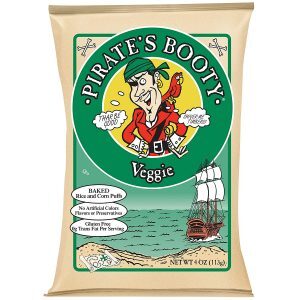
Raw Wraps
I tried these wraps at the Seed Food & Wine Festival in Miami. They were good! They are dehydrated and raw so if you’re not used to that taste it might be a little strange at first. But fun wrap to have to make burritos and sandwiches, for you or kids!
[image error]
Shawnee’s Greenthumb Popcorn
This funky popcorn is super yum! It’s certified Organic and non-GMO. It has ingredients like nutritional yeast, cayenne pepper, kelp powder, and garlic powder, so the popcorn tastes unlike any other bagged popcorn I’ve had before. I found out about this snack at the Seed Food & Wine Festival.
[image error]
Follow Your Heart Provolone
I found these at the Natural Products West Expo.. It doesn’t look like much but it was actually really good! I want to get some for Bear!
[image error]
Rhythm Superfoods Broccoli Bites
These bites are interesting and different. If you’re into kale chips, you might like them! I tried them briefly at the Natural Products Expo West.
[image error]
Late July Peanut Butter Minis
Back to Nature Classic Rounds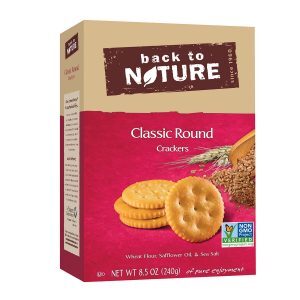
Simple Mills Rosemary & Sea Salt Almond Cracker
Yum!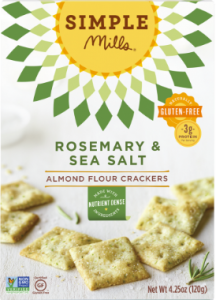
Uncle Eddies Vegan Cookies
Excellent!!
[image error]
Newman’s Own Wheat Free Dairy Free Creme Filled Chocolate Cookies
These taste like full-on ‘Oreos’ — but they’re cleaner! Insane!
[image error]
Angela’s Sweet Spot Peanut Butter Chocolate Chip Cookie
= yum city!!
[image error]
Dandies Marshmallows
Bear likes eating these just as is. They’re cute and fun!
[image error]
NuGo Organic Double Dark Chocolate Bar
This one includes cane sugar so this is a special treat! The brown rice crisp adds a crunchy fun texture. Hits a chocolate craving for sure.
[image error]
Ruby Rockets
Tasty and free of added sugar!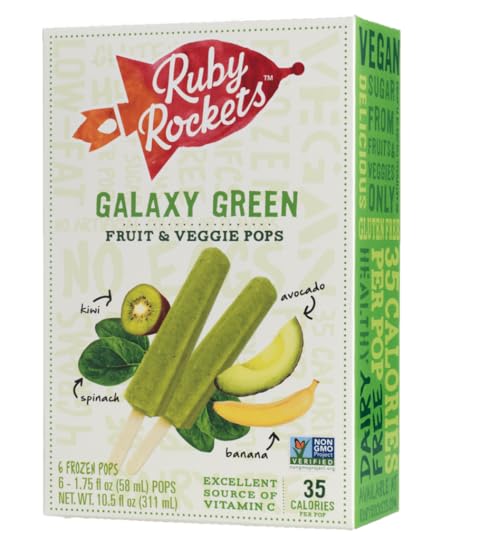
If you want some more ideas on what to pack your little one for lunch, my friend Roxanne also shared thoughts some great ideas about talking to your school about incorporating more healthy options, definitely worth checking out.
July 15, 2023
19 Ways to Ethically Donate Used Household Items
You have no idea the good your old stuff could be doing! Rather than letting things you no longer have use for decompose and off-gas in a big, heaping pile of trash, ethically purge those items instead and donate your used household items.
It’s easier than you think! There is nothing better than the feeling of a good, deep cleanse. It will help you to be more mindful of your consumerism. Be sure to ask yourself “Is this something I truly need/ Will it truly give me joy/ Does this piece have longevity in my life” before you bring anything home. The less clutter you accumulate, the less you’ll have to reassign to the landfill in the future.
Think about the excitement you’d feel if someone surprised you with a vintage, storied handbag or a fun piece of antique jewelry. There is almost nothing from your home that needs to go in a garbage can. So if there is something you don’t know what to do with – you will after reading this list!
How to Donate Used Household ItemsGive away items to someone you know would love or could use a particular thing. For example; let’s just assume you have a 4-year-old boy – find a friend with a 2-year-old boy and give her all your small boys clothes and out-aged toys. Hand-me-downs are called “pre-loved” for a reason! Better yet, join a Facebook “swap” group and dole out your outgrown sizes/ stuff for things that are of use to you.Hold a clothing swap with your crew, but open it up to include housewares, toys, etc. Serve refreshments, play fun music, and make it a girls-night-in sort of gathering!Sell your clothing to a local consignment/ resale shop, make some cash and clean out your unused duds. Note that there are upscale consignment shops that are very picky and ones that are open to all brands in good condition. Google consignment shops in your area and visit their websites to get a vibe for what they are looking for before you waste your time bringing in 5 garbage bags of clothes.Order a ThredUp bag and toss everything (men/women/kids/ shoes/ bags) you no longer want in it and ship it back (free) to them – You can opt to have them recycle all items they don’t accept so you don’t end up in the same conundrum you were originally in. There are many other apps and sites like Poshmark that you can sell your stuff on, but with those you have to upload the pix and run the sale yourself – which may take more time than you’re interested in spending – you most likely, however, make more money. Buffalo Exchange is now offering selling by mail too.Send high-end items to The RealReal and make some dough or web store credit – only send in big-name designers for this one though – but working with them always pays off. The great thing about selling to The RealReal is conscious eco-fashion designers like Stella McCartney offer you incentives to earn $100 to shop Stella when you consign any Stella McCartney item on The RealReal.Sell your items yourself on eBay – there’s no end to what you can sell. You can choose to donate that additional income to your favorite charity to keep motivated to list more items.Have a yard sale.Use GiveBackBox – which will allow you to print out a free shipping label to donate your old items to a local charity in need.Donate to any local shelter, hospital, home for women/ children, homeless shelter, church, synagogue, mosque, pre-school, local public school, library, police or fire station, etc. My kids’ schools were always more than overjoyed to take any toys or books my kids had outgrown. Before presuming your local school isn’t interested in your gently used items, ask! Covid precautions mean that many non-profits aren’t currently accepting donations – so make sure to call or email before donating.If you have a handful of items of the same kind, Google the type of item you want to donate – example: “donate old shoes,” sure enough – up pops soles4souls.org which allows you to ship your old shoes (for free) to be distributed in poverty-stricken countries. Donate your old glasses so your glasses become someone else’s best hope at seeing.Ethically recycle non-working/ destroyed items. There are textile (clothing) recycling bins all over – google your local one if you can’t find it easily. The same goes for electronic equipment. There are often free shipping programs you can use to ship items to recycling centers not close to you. TerraCycle will take nearly anything you could possibly imagine recycling, and more!Sell your old electronics. A number of stores and sites will take them. ( See a list here .) Send them your old working (or even nonworking depending on the product.) electronics (mainly phones and computers and iPads) and these items don’t sit in a landfill forever, and you get paid for your conscious efforts!Donate old sheets, towels, carpets, rugs, teddy bears, crockery, heating pads, baby gates/ baby playpens, and rags to any animal shelters, rescue groups, or animal foster families. There is a company that accepts old teddy bears which they use to make into new dog toys! Same with old sheets ! Wildlife rescues will also accept old fur coats to rehabilitate orphaned wildlife.Sell anything using your social media accounts, Instagram or Facebook, etc. – this keeps buyers close by, and the sales easier, and more trustworthy if from your inner circle or friends of friends.Take your penny jar/ spare change to the bank and put it in your account or give it to your kids to bring to their school to donate to a “penny fundraiser.”Offer your goods up for free on Freecycle or CraigsList – you’d be shocked what people want! Extra 2 packs of shower caps? Half a mannequin? A used cat tree? All these things are prime Freecycle fare and bonus – they pick up and you don’t have to deal with pick up or booking a Goodwill pick up! Live in a neighborhood where people drive your front yard? Leave your items on your lawn with a “Free to a good home!” sign for people to grab what they want.Ever seen the waste that gets tossed in the trash after a catered event? There are groups like Rescuing Leftover Cuisine that will physically pick up every leftover and disseminate them to the homeless! You can also call ahead to your local shelter or boys & girls club and offer them your leftovers so they can expect them and be ready to receive them the day of your event. Want a more hands-on approach? Drive your leftovers to an area where there are folks in need, and give them out.Be creative: reinvent and repurpose old items. Example: We had an old bookshelf of about 5 years that was useless and broken as a bookshelf so we turned it on its side and used it as a toy storage for the kids. It stayed that way for at least 5 years before we recycled it. Use Pinterest to come up with new ideas to reuse items that have overstayed their welcome in their current incarnation.Finally; Maybe you don’t actually need to get rid of it – maybe it just needs a repair or a facelift. Example; I once had a stained old faux-leather beige knapsack from college. I loved this knapsack and didn’t want to let it go, so I brought it to the shoemaker and he dyed it chocolate brown. And, voila – my old backpack lasted another 10 years til I decided to donate it to a clothing drive.July 10, 2023
Shopping Secondhand Has So Many Benefits: Here’s Why I Love It
Shopping secondhand has never been easier or more important. According to Earth.org, the average American throws away more than 80 pounds of clothes every year. That’s about 17 million tons of textile waste going to landfills per year where it leaches toxic chemicals that pollute water and air and planet-warming gases.
But fashion’s problems don’t stop there. New clothing is just as bad for the planet, using up resources, polluting water, and producing emissions. Overall, the fashion industry produces about ten percent of global carbon emissions and consumes a whopping 1.5 trillion liters of water annually. Crazy, right?
Benefits of shopping secondhandBy shopping secondhand, you’re actively reducing the demand for new clothing production. This means less pollution, less waste, and less water consumption. Did you know that it takes about 2,700 liters of water to make just one cotton T-shirt? Just think about how much water you’re saving by choosing to shop secondhand.
Another fantastic reason to shop secondhand is the cost. Let’s be honest, we all love a good bargain, and secondhand stores are the perfect place to find deals on clothes. You can often find high-quality, barely worn items for a fraction of the retail price. The reason you find high-quality clothes more often when shopping secondhand? Because they were designed to last, unlike the fast fashion stuff that starts to show wear after just a few washes.
By shopping secondhand, you’re not only saving the environment, but you’re also saving your wallet.
One of my favorite things about secondhand shopping is that you’re also more likely to find one-of-a-kind items. Forget about showing up to a party in the same dress as someone else (aka when Cher says to Amber in Clueless, “did you steal that from my laundry bin?”); with secondhand clothing, you can create a truly unique wardrobe that reflects your personality and style. You can also find on-trend new items for a fraction of the cost — so you don’t have to worry about being not on-trend by buying secondhand.
Shopping secondhand is also an excellent way to support your local community. By choosing to buy from thrift stores, consignment shops, or charity shops, you’re often supporting small businesses and contributing to the local economy. Plus, many charity shops donate their proceeds to various community causes, so your purchase can make a difference in more ways than one.
Of course, secondhand shopping might not always be an option. Whether it’s due to lack of availability, sizing issues, or personal preferences, sometimes we just need to buy new clothes. In those cases, I think it’s so important to focus on purchasing sustainable items made from eco-friendly materials, with ethical labor practices and a reduced environmental impact. By choosing to buy sustainable new items, you’re supporting brands that prioritize the health of our planet and the well-being of their workers.
One way to identify sustainable brands is by looking for certifications such as Fair Trade, Global Organic Textile Standard (GOTS), or Bluesign. These certifications ensure that the brand’s products meet strict environmental, social, and ethical standards.
Additionally, you can look for brands that use eco-friendly materials. This includes organic cotton, Tencel, hemp, and recycled fabrics. These materials consume less water and energy during production and are less harmful to the environment.
Another reason to opt for sustainable fashion is its durability. Fast fashion might seem like a great deal, but those cheap clothes often wear out quickly, leading to more waste. Sustainable brands typically focus on producing high-quality items that are designed to last, ultimately reducing your wardrobe’s environmental footprint.
Sustainable fashion brandsWhen you’re exploring new options, consider the company’s ethical practices. Research the brand’s labor policies and make sure they treat their workers fairly, pay fair wages, and provide safe working conditions. By supporting brands that prioritize ethics, you’re sending a message to the fashion industry that exploitation is not acceptable.
New sustainable clothes can be pricier than what you’re used to, but not always! And remember, you’re investing in quality, durability, and ethical practices. In the long run, you’ll likely save money by not having to replace cheap, fast-fashion items that wear out quickly.
And when all else fails, buy new items as needed whether or not they’re from a super sustainable brand. For me, that means making sure it’s a vegan item — avoiding wool, silk, leather, and fur. By opting for vegan clothing, you can further reduce your impact on the environment and you’re choosing the most ethical option.
There are also health benefits of wearing natural materials, too, as your skin wants to be able to breathe, which plastic-based nylon and polyester prevent.
Cotton, especially if it’s organic, is better for your skin and the planet. But buying secondhand cotton (T-shirts, denim, dresses, etc) helps keep those items out of landfills. Most cotton is heavily sprayed with pesticides — and while the residues of those are typically long gone by the time you find the item at the secondhand store,
And while I don’t ever buy new wool, if you can use some used wool that you found in a secondhand store, it’s a natural fiber and much better than sending it to a landfill. The same can go for leather; while I am not personally going to wear a cow-based leather jacket, I will wear a pair of old leather shoes that I found in a secondhand store. Why the difference? Well, for one, so many shoes are made from leather and jackets come in a range of other materials. Plus, shoes just go on your feet so you’re not so blatantly flaunting the material linked to so much animal suffering and destruction of the planet.
How to shop secondhandSo, how can you start making more sustainable choices when shopping for new clothes? Here are a few tips to help you out:
Research thrift stores in your town. Beyond the big ones like Goodwill, are there independently owned shops you could visit? Something to keep in mind about smaller shops is they prioritize curation so the selection is excellent but they can be pricier.Explore secondhand platforms online such as The RealReal, Vestiaire Collective, and ThredUp. But there are lots to check out.Do your research: Before making a purchase, take the time to learn about a brand and its sustainability efforts. Look for certifications, read about their materials, and check out their labor practices.Prioritize quality over quantity: Instead of buying numerous cheap, trendy items, invest in high-quality pieces that will last for years. Focus on timeless, versatile pieces that can be easily mixed and matched with the rest of your wardrobe.Care for your clothes: Properly caring for your clothes can significantly extend their lifespan. Follow the care instructions on the label, wash your clothes less frequently, and avoid harsh detergents. I have some tips here and useful information about clothes washing here and here. Also, when it comes to washing, almost every item of clothing that says dry clean only can in most cases be hand-washed. I use a vodka spray mixed with water; it’s a trick I learned from costume dressers who always did this and it works so well. Repair, reuse, and upcycle: Instead of throwing away damaged clothes, try to repair them or repurpose them into something new. Get creative and give new life to old items.Support small, local businesses: Shopping from smaller, local businesses often means you’re supporting artisans and craftsmen who are more likely to use eco-friendly materials and ethical practices.Educate yourself and others: Share what you’ve learned about sustainable fashion with your friends and family. The more people know about the importance of ethical and eco-friendly clothing, the more demand there will be for sustainable options.July 7, 2023
Is a Vegan Diet Healthy? Is It Expensive? 5 Myths About Eating Plant-Based Explored
Is a vegan diet healthy? Is it expensive? Nutritionist Sharon Palmer dives into the plant-based diet myths to shine a light on the truth.
Vegan diets have never been more popular—in fact they’re becoming increasingly mainstream—yet there’s still a flurry of misconceptions and outright myths about this plant-based way of eating. Yes, you can get enough protein on a completely plant-based diet. And no, it doesn’t have to be an expensive lifestyle. And the myths keep rolling in. So, it’s time to separate fiction from fact and shatter these myths!
Busted! Feasting on a super-healthful plant-based pattern that includes balanced meals packed with a variety of whole grains, plant proteins, vegetables, fruits, and healthy fats pretty much ensures you’re meeting your nutrient needs. It’s a way better diet than the Standard American Diet loaded with unhealthy saturated fats, excess sodium, sugar, and processed ingredients.
In fact, research shows that on average, vegans, like most people regardless of diet, meet their nutrient needs daily. Here’s a little bit more information on how you can feel good about reaching goals for these important nutrients.
Protein: There are plenty of plant protein sources to go around! In fact, some contain good amounts of all the essential amino acids in one serving, such as soy foods and quinoa. Other plant foods, such as beans, nuts, seeds, and whole grains, provide ample protein.
The key to any diet is to eat a variety of foods throughout your day to bring a balance of nutrients. Did you know that even veggies contribute to your protein intake? Try to include at least one high protein source—black beans, lentils, almonds, tofu, chickpeas, peanut butter, chia seeds—at each meal and snack.
Think tofu scramble or oatmeal for breakfast, black bean chili or quinoa grain bowl for lunch, hummus with whole-grain pita for a snack, and roasted butternut squash stuffed with pistachios and figs or a black bean quinoa veggie burger for dinner. Sounds delicious, doesn’t it?
Iron: Found in the hemoglobin of red blood cells, iron is necessary for oxygen transport throughout the body, in addition to other important functions, including immunity and DNA synthesis.
Heme iron (from animal sources) is absorbed better than non-heme iron (from plant sources), but research has also linked too much heme iron with health risks. Sources of iron for vegans include grains, legumes, leafy greens, tofu, and enriched cereals.
Due to the reduced bioavailability of iron, it’s recommended that vegetarians and vegans consume 1.8 times the RDA for iron. And the presence of vitamin C with iron sources can increase its absorption level; plus, cooking foods in an iron skillet can increase iron intake. Including a variety of these foods in the diet can help ensure you meet your iron needs.
Busted! Plant-based eating doesn’t have to break the bank, in fact, it will likely save you money. Often, animal protein is the most expensive food on the plate for omnivores.
On the other hand, beans, peanuts, and tofu are economical protein choices. The real key to creating a delicious, healthy plant-based food pantry without maxing out your food budget is pretty simple: eat real food. Sure, fake meats, plant-based frozen entrees, and packaged foods may be easy and convenient, but they are often more costly than creating meals out of whole plants yourself.
Get into the kitchen and cook meals yourself, and you’ll save those dollars! Here are a few hints for eating plant-based on a budget.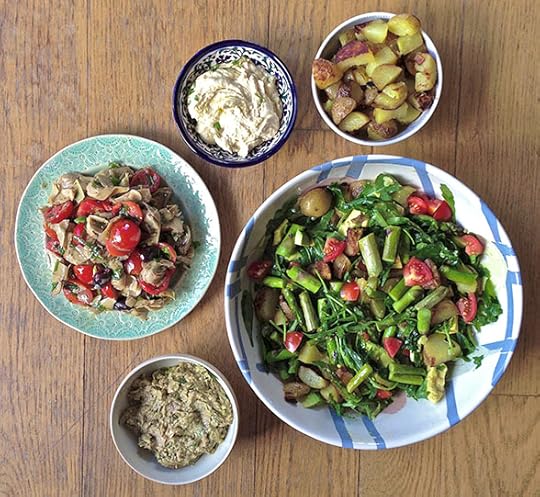
Bulk Bins: Pack your pantry with staples, like lentils, beans, and whole grains, which are typically cheaper than their packaged counterparts. Look for bulk spices as well, which are perfect when you only need 1-2 teaspoons for a recipe.
Buy Seasonal Produce: Make the most of fresh produce when it’s in season—oranges in the winter, squash in the fall, strawberries in the summer. You will find them offered at more reasonable prices then too.
Frozen (and Canned Foods) Aisle: Take advantage of less costly—and sometimes better tasting—preserved fruits and vegetables, like antioxidant-rich frozen berries, which are picked at the peak of ripeness and quick-frozen to help preserve their integrity.
“Ugly” Produce: You can find great deals on fresh produce when you opt for the imperfect ones. Farmers’ markets, as well as some grocery stores, are beginning to showcase those “ugly”, less than perfect apples, squash, and beets by offering them at lower prices. You’ll not only save cash, you’ll help offset the food waste in our country.
Busted! A diet that includes a variety of nutritious foods, such as vegetables, fruits, whole grains, legumes, nuts, and seeds, in addition to those unhealthy treat foods, is most sustainable and is going to lead to the best overall health in the long-term.
Eating should be enjoyable, not overly restrictive, so focus on variety and flavor when preparing meals. Seasoning with heart-healthy olive oil and a small sprinkle of sea salt can enhance any dish.
And when you desire a little indulgence, give in on occasion, just be sure to truly savor it as a once-in-a-while experience.
Busted! It’s quite common for diners to request a vegan meal option at restaurants, both fine dining, and even fast food establishments today.
Throughout the country and even around the world, plant-based eating is catching on for health and environmental benefits. In fact, many menus now feature vegan options, making it really convenient. If you’re unsure about options when dining out, do your homework and review the menu online or place a phone call in advance.
You can also download the Happy Cow app for vegan dining options in your area.
As a guest in someone’s home, always politely remind your host that you are vegan ahead of time, and offer to bring your favorite casserole or hearty salad to put them at ease (which will ensure you have something satisfying too!). You might be surprised that your dish turns out to be the star of the meal! You’ve got this!
Busted! When it comes to a vegan diet, there’s often the assumption that it is very expensive, and largely an upper class, predominantly white movement. But this style of eating is accessible to all and has been prominent in cultures around the U.S. and the globe.
In fact, plant-based diets have been part of traditional eating patterns in cultures through the millennia—in many cultures, such as countries in the Mediterranean, South America, Asia, and Africa, communities once ate primarily plant-based diets, with low animal food intake, as part of their indigenous foodways.
Rather than try to adopt another person’s style of plant-based eating, foods, and culinary styles, look to your own food culture and traditions that are plant-based.
You don’t have to follow every social media trend and purchase costly superfoods to eat a healthy, wholesome, kind, vegan diet. It can be as simple, unassuming, accessible, and delicious as beans, lentils, brown rice, and seasonal produce.
Plant-based eating can be healthy, delicious, and sustainable! Try this recipe for Farmers Market Tempeh Hash or these Toasted Nori Burritos to get inspired.
The 7 Best Brands for Cute, Comfy Vegan Sneakers
I am really excited about all of these vegan sneakers! Whether hitting the trails, the beach, or just looking cute, finding the best pair of summer sneakers is a must. These companies are also all doing things in a responsible manner while being cute and chic at the same time. How great is that? I’ve found a few really incredible sustainable and vegan brands I’d love to share with you.
The Best Vegan Sneakers for Summer
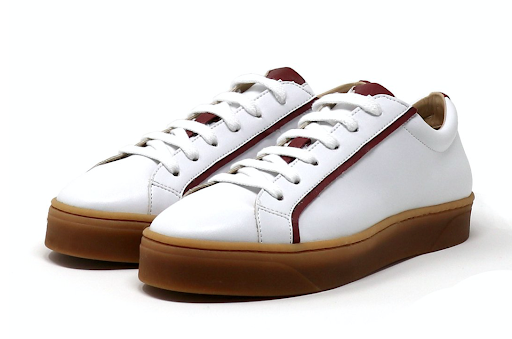 1. Sylven
1. SylvenThese cute sneaks are made from apple leather, from (now fully!) vegan shoe designer, Sylven. The outsole is made from a sustainable material—lactae hevea—a highly renewable natural rubber derived from the sap of the hevea tree. Awesome!
Get them here.
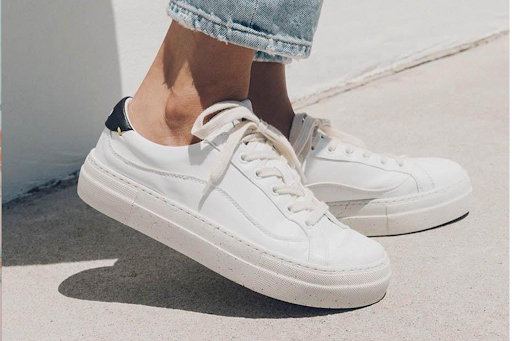 2. Soludos Yebo
2. Soludos YeboMade from biobased leather, recycled polyester, and the laces are organic cotton, too. These cute and comfy stylish sneaks come in four colors.
Get them here.

3. Nike
Like a number of mainstream brands, Nike is now doing sustainable shoes. This style is called the Space Hippie—and it keeps selling out. (I can’t even get my hands on them!) It’s the lowest carbon footprint shoe that Nike has made. The shoe features 25% recycled materials, and 75% recycled upper, made from recycled plastic bottles and t-shirt scraps. Keep it up, Nike!
Get them here.
 4. Lane Eight
4. Lane EightI like my grey sneakers from Lane Eight. I wear them hiking and for working out. They are made with vegan microfiber, recycled polyester threads, and each shoe is made from 11 recycled plastic bottles! The insole is made from algae that give back 31.5 liters of water back to the oceans, and reduces 64 cubic meters of carbon from the atmosphere.
Shop my comfy grey ones:
Get them here.
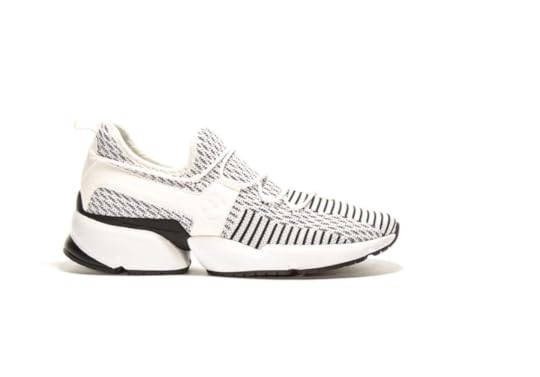 5. Avre
5. AvreI have two pairs of these fun Avre sneakers. They are made from recycled plastic which is melted down, reformulated, and spun into yarn. Overall this helps reduce energy, waste, and water. I have a black and white pair, and a pink one. The pink is a fun pop of color. I’ve been wearing them both on hikes with leggings and sweats.
Shop the black and white style here.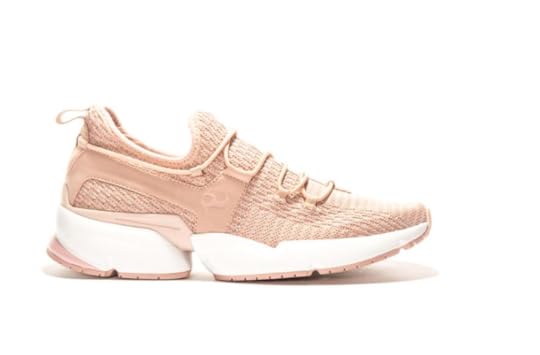
And the pink ones here.
 6. Veja
6. VejaI love my Veja sneakers with jeans, dresses, and leggings. The company offers a few vegan style options and has cute kiddo styles, too. I have a white pair and find that I’m wearing them in the spring and fall the most. They are made of faux leather, or canvas. Mine are faux leather with a rubber sole.
Looks like mine are sold out but shop a similar pair here:
Get them here.
 7. Cariuma
7. CariumaThis brand is not entirely vegan, but has a few really nice vegan options and has sustainability practices: responsibly sourced materials, fair wages, and givebacks to charitable organizations. I like the white canvas lace-ups with jeans and dresses to style them down.
Get them here.
Happy Shopping!
Xo,
Alicia
June 28, 2023
My Favorite Eco Swimwear Brands and Suits For Summer
It’s that time of the year again—things are heating up and I want to jump in the pool with Bear. Or go to France with my pals….whatever the occasion, we need swimsuits. If you’re in need of a new one, earth-friendly, sustainable bathing suits are the way to go. And the great news? There are finally some really amazing options out there.
I have been on the hunt for great-fitting, chic, and sustainable swimwear. These are my favorite picks.
I love how focused on sustainability this zero waste swimwear brand is. Everything from using recycled paper for their patternmaking to using regenerated nylon yarns. So great.

Top:
Get it here.
Bottom:
Get it here.
I don’t love this top so much on me…but the bottoms I’m so excited about! Pairing with so many of my stray tops.
Vitamin A also uses recycled fabrics- and ECONYL which is made from recycled plastic bottles. They are committed to sustainability from beginning to end of their production process.
Get it here.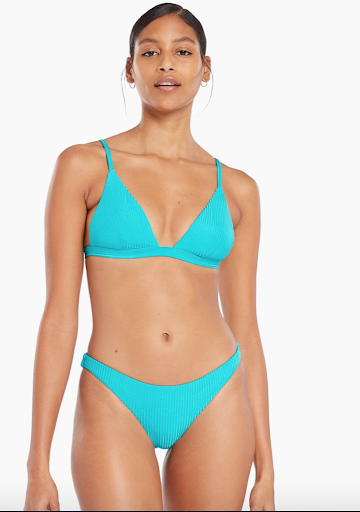
Get it here.
NuSwim uses fabric that is made from 100% regenerated ocean waste, and also uses 100% organic cotton in the non-swim pieces.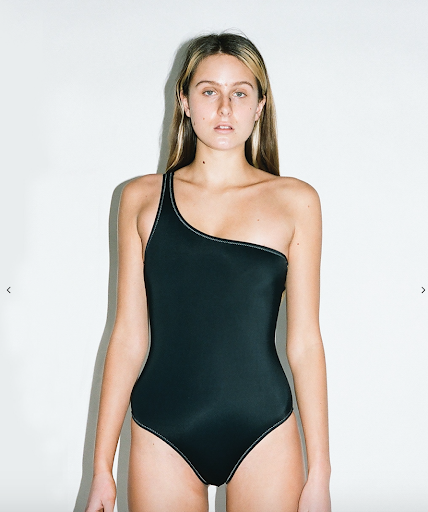
Get it here.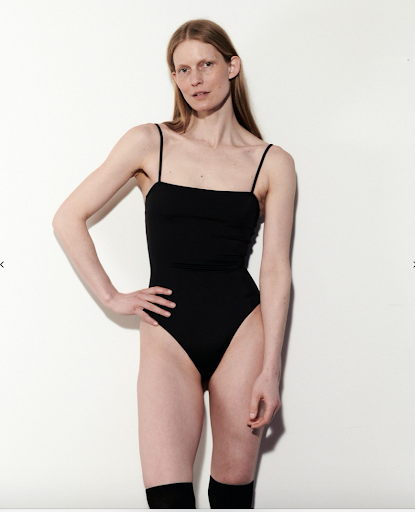
Get it here.
Alicia Silverstone's Blog
- Alicia Silverstone's profile
- 85 followers



